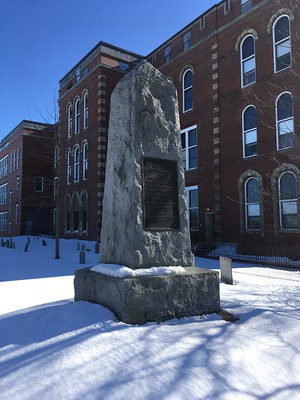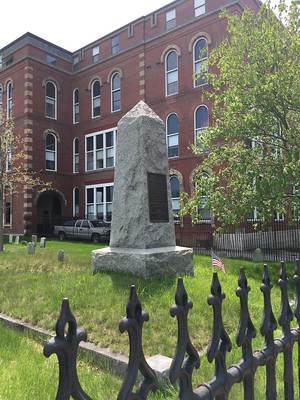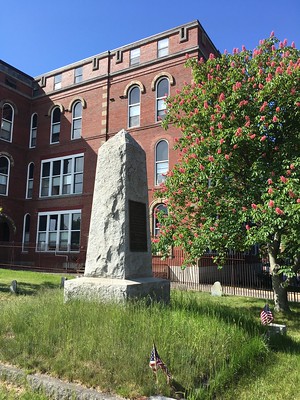Eastern Cemetery and the American Revolution
Portland’s revolutionary past is preserved at Eastern Cemetery. The generation of 1776 is laid to rest here. Soldiers and sailors who fought for independence. Town officials. Patriot activists. Loyalists. Hundreds of residents who watched their houses burn during the bombardment of October 1775.
Learn more about Eastern Cemetery war veterans. The Known Veterans with Plots in Eastern Cemetery table allows you to sort by war.
A large section of the present cemetery served as the parade ground where the local militia trained. This is where troops mustered in 1775 for the march to Cambridge to join Washington’s army.
The Revolutionary War Monument (photos on Flickr) in the cemetery’s northwest corner, erected in 1909 by the Elizabeth Wadsworth Chapter of the Daughters of the American Revolution, honors the “the brave defenders of our country who made her foundations so enduring.”
Above: Revolutionary War Monument in Eastern Cemetery
Timeline: Falmouth at the Dawn of the Revolution
Before the war, Falmouth, as Portland was known then, was a town of about 2,000 people, governed by Massachusetts. Resistance to the Stamp Act of 1765 and other measures of the British goverment mirrored anti-government protests in Boston, a two-day ride away. Following is a timeline of events related to the resistance both in Falmouth and elsewhere.
January 1766
Location: Falmouth
A mob seizes revenue stamps at the Customs House and burns them in a bonfire. Repeal of the Stamp Act in May is met with public rejoicing.
June 1774
Location: Falmouth
Muffled bells of the First Parish Church toll from dawn to dusk to protest the closure of the port of Boston by the British government.
April 18, 1775
Paul Revere’s ride and “the shot heard round the world,” also known as the Battle of Lexington and Concord. This event was given lasting fame in a poem written by Henry Wadsworth Longfellow.
April 21, 1775
Location: Falmouth
News of the battles at Lexington and Concord reaches Falmouth. Local militia start out for Cambridge, where Revolutionary forces are beseiging the British army occupying Boston.
May 9, 1775
Location: Falmouth
Brunswick militia under Col. Samuel Thompson kidnap British Naval officer Henry Mowat, whose sloop, HMS Canceaux, is protecting loyalist commerce. After Mowat is released, militia loot the houses of loyalists William Tyng and Samuel Coulson.
May 10, 1775
Benedict Arnold and Ethan Allen capture Fort Ticonderoga with its store of big guns.
June 12, 1775
Coulson returns, and Sheriff Tyng aboard.
June 17, 1775
The Battle of Bunker Hill where among the flags flown was a pine tree flag. British policy about trees contributed to rebelliousness.
August 23, 1775
King George III declares the American colonies to be in a state of “open and avowed rebellion.”
October 13, 1775
US (Continental) Navy established.
October 17–18, 1775
Location: Falmouth
Mowat returns to Falmouth harbor to punish the town. His attack fleet opens fire on the morning of the 18th and continues its bombardment until 6pm, leaving the town in ruins and most residents homeless.
November 17, 1775
Erstwhile bookseller Henry Knox departs Boston to retrieve the Fort Ticonderoga cannons
January 25, 1776
Knox delivers 60 tons of arms and armaments to General Washington in Cambridge.
March 5, 1776
The British in Boston awaken to the largest of the cannons set up on Dorchester Heights.
March 17, 1776
The British evacuate Boston—an event still commemorated there every spring.
Some Eastern Cemetery Revolutionary Personalities
Tabitha Longfellow (1749–1777)
Tabitha and Stephen Longfellow’s large house on the beach near present-day Fore and India streets would have been one of the first destroyed in the bombardment of October 1775. They did not rebuild, and Tabitha died two years later at the family farm in Gorham. Ninety years later, her great-grandson, Henry Wadsworth Longfellow, would immortalize the events of 1775 in his poem “Paul Revere’s Ride.” She rests in plot F:33.
Commodore Edward Preble (1761–1807)
As a young officer in the Massachusetts Navy, Preble was captured by the British in 1781 and held on a vile prison ship off New York harbor. He was saved from likely death by the intervention of Loyalist and fellow townsman William Tyng. Preble later commanded the American fleet in the First Barbary War, during which he set down the principles that would govern the new American Navy. He rests in Tomb A:65.
Pvt. Benjamin Tukey (1749–1777)
As Falmouth wildly celebrated the great American victory at Saratoga with punch-drinking and cannon fire, artilleryman Tukey was mortally wounded when a misfire blew off his right arm. He rests in plot F:59B.
Col. William (1737–1807) & Elizabeth Ross (1750–1831) Tyng
The Tyngs were the most prominent Loyalists in Falmouth. William was the Royal Sheriff. Elizabeth’s Scottish father was a friend of the British Prime Minister. Their house was repeatedly beset by rebel mobs. After the Battle of Lexington and Concord, Tyng decamped to Canada, and then to British-occupied New York. He returned to Maine after the war, and lived out his life with Elizabeth in Gorham. They rest beneath the broken monument at E:38.
Ensign William Hans (1757–1831)
Billy Hans was one of the large contingent of Maine soldiers at Valley Forge. After the war, he personified the veteran who has fallen on hard times. He was illiterate and unable to work, likely owing to alcoholism. His 1818 military pension application stated that his family was supported by the Overseer of the Poor. He rests near the front gate in plot A:4:13.
Capt. David Cook (1751–1836)
Most Maine soldiers and sailors survived the war. Captain of Artillery David Cook’s survival was considered miraculous. Shot through the lungs at the battle of Monmouth, he survived and continued to serve for two more years. He rests in plot B:11:10.
Pvt. Lewis Shepherd (1751–1832)
Jamaican native Lewis Shepherd was enslaved at the time of his enlistment in the Massachusetts line of the Continental Army in 1777. He served at Valley Forge through Saratoga, and was discharged in 1780. He received a federal pension for his service. He rests in plot A:24-27.
Capt. Lemuel Moody (1767–1846)
Only seven years old when the war began, Moody joined the militia as a water boy at the age of 10. After a career at sea, he built and operated the Portland Observatory. He rests in tomb A:60.
Sgt. William Moody (1756–1821)
Lemuel Moody’s older brother was a drummer with the 1779 Penobscot Expedition, a disastrous attempt to drive British forces from Bagaduce (now Castine). William kept a diary that recounts the destruction of the American fleet and the disorderly retreat through the woods by survivors. He rests in plot G:19.
Col. Enoch Freeman (1706–1788)
At one time or another, Freeman held every important position in town. A leader of the patriot or Whig faction, he chaired the Committee of Safety and was a representive to the Massachusetts Provincial Congress. He rests in plot G:11.


